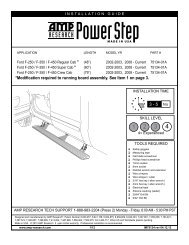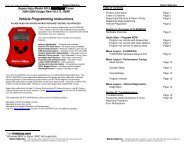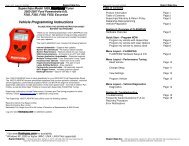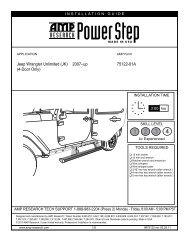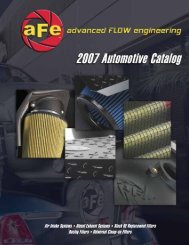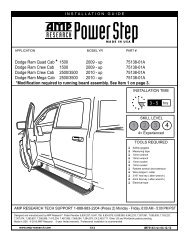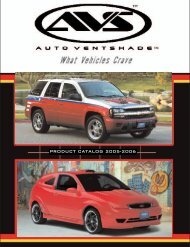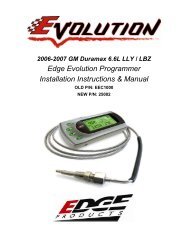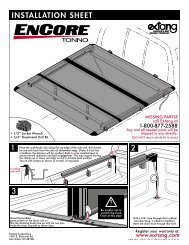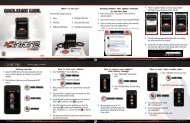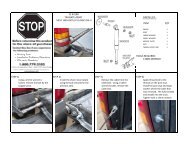CargoGlide Installation Instructions - RealTruck.com
CargoGlide Installation Instructions - RealTruck.com
CargoGlide Installation Instructions - RealTruck.com
Create successful ePaper yourself
Turn your PDF publications into a flip-book with our unique Google optimized e-Paper software.
<strong>Installation</strong> <strong>Instructions</strong><br />
NOTE: It is the responsibility of the installer to ensure the slide unit is securely fastened to a base that<br />
will provide safe and reliable operation. The many variations in usage and placements of a slide unit<br />
present unique requirements; and the following information is only intended to be general in nature to<br />
provide awareness to the installer to look for and consider issues that may affect safety and reliability.<br />
Usage<br />
All slide units are designed for ideal use in static and level conditions. When installed in a vehicle, the<br />
<strong>CargoGlide</strong> unit must be closed and latched securely prior to and during any vehicle movement. The<br />
vehicle must be parked in a level position prior to unlocking and extending a slide unit or the weight of<br />
your cargo could be difficult or dangerous to move.<br />
Forces<br />
The slide unit must be securely fastened to a base floor or other structure to resist movement. A tipping<br />
force is applied to the unit when it is extended, which is countered by the attachments at the front (cab<br />
side) and middle of the unit. Furthermore, vehicle acceleration, cornering and braking will result in<br />
additional forces affecting your cargo and the slide unit. Impacts due to dropping a load will result in<br />
temporarily higher forces seen by the fasteners and should be avoided.<br />
Position & Check Clearances<br />
CAUTION: When opening the slide the clearance at the tailgate may need to be adjusted to avoid serious<br />
injury to your fingers.<br />
1. Set the <strong>CargoGlide</strong> unit into the position it will be installed in.<br />
2. Center the <strong>CargoGlide</strong> unit between wheel wells in the bed of the truck or van, set the <strong>CargoGlide</strong><br />
forward toward the cab of the truck, leave about ½ to 1” of space between the front wall of the truck<br />
bed and the <strong>CargoGlide</strong>.<br />
3. Check to ensure that nothing interferes with the location and operation of the slide including<br />
clearance of the tailgate or doorway edges. Allowing a small gap ( at least 1/2) to ac<strong>com</strong>modate any<br />
slide deflection due to loads and slight misalignments due to the installation itself.<br />
4. Prior to drilling holes for Plus-Nut installations confirm there are no Gas Lines or other obstructions<br />
under truck or van bed where you plan to drill.<br />
Attachment Points<br />
• Normally, a slide unit will have 4 to 6 points to attach to the base. A single direction slide unit must<br />
have at least the 4 rear points (2 cab end and 2 middle points) fastened and a dual direction slide must<br />
have at least 6 points (2 at both ends and 2 middle points) attached.<br />
• Mark the vehicle bed in the locations you will need to drill holes.
Fasteners<br />
1. Provided is our Plus-Nut fastening system for easy installation from the top of the vehicle bed so you<br />
don’t have to crawl under your vehicle to bolt in your slide.<br />
2. Typical slide unit attachment is made by use of the provided Plus-nut anchor, a 5/16″ USS washer and<br />
1.5” long 5/16″ hex tap bolt.<br />
3. Drill a 7/16″ or 1/2″ hole in the vehicle bed at each of your marked locations to accept the Plus-Nut<br />
anchors.<br />
4. Move the Slide a few inches out of your way and Insert a Plus-Nut anchor into each hole.<br />
5. Using the included Plus-Nut install tool (tall grey metal nut with no threads and gripper teeth on one<br />
end), a 2” long 5/16 bolt and a steel washer, Insert the bolt through the washer then through the<br />
smooth end of the install tool and thread into the Plus-Nut you are installing.<br />
6. Using a wrench to hold the install tool in place, use another wrench or socket on a wrench or an<br />
impact driver drill to tighten the bolt into the Plus-Nut. As you tighten the bolt you will feel strong<br />
resistance, then light resistance, then strong resistance again as it collapses the Plus-Nut anchor<br />
clamping to the underside of the vehicle bed.<br />
After the Plus-Nut has been fully <strong>com</strong>pressed, remove the bolt and repeat on the other Plus-Nuts you<br />
are installing.<br />
7. If the Plus-Nut is at an angle because of the slope of the vehicle bed ribs making it difficult to thread<br />
the bolt in, either leave it partially un<strong>com</strong>pressed so you can still change its angle, and finish tightening<br />
after you start all of the install bolts through the <strong>CargoGlide</strong> frame, or if you clamp them too tight for<br />
that you may be able to thread a bolt a few turns in to the Plus-Nut from underneath the vehicle and<br />
use pliers to hold it straight enough for someone inside the vehicle bed to thread their bolt a few turns<br />
through the frame from above, then remove the temporary bolt below before you finish tightening once<br />
the upper one starts to thread.<br />
8. Move the Slide back in to place over the Plus-Nuts and install with a 1.5” long 5/16” bolt through a<br />
5/16 washer then through the hole in the slide frame and into the Plus-Nut and tighten securely in each<br />
of your mounting locations.<br />
Shims<br />
Many vehicle <strong>com</strong>partments have a lip on the bottom of the bed, or angled tailgates and other<br />
obstructions above the floor level. If your vehicle has similar obstructions some <strong>CargoGlide</strong> models may<br />
have to be shimmed up to clear the obstruction or tailgate angle during extension (Make sure to leave<br />
enough clearance for the slide AND your fingers). Shims can be many alternatives including wood, metal<br />
tubing, etc. The shims must be placed under all of the slide areas that normally contact the floor to<br />
provide necessary support. Optional Shim Kits are available from <strong>CargoGlide</strong> for some models.
<strong>CargoGlide</strong> CG1000 and <strong>CargoGlide</strong> CG1500HD models have built in height adjusters for easy adjustment<br />
to clear various tailgate angles or other clearance issues. Simply twist the adjustment plate to reach the<br />
appropriate height. If this feature is used, add spacers to mid cross member before tightening down<br />
bolts, so the bottom frame sides remain straight.<br />
Frame Separation<br />
<strong>CargoGlide</strong> slide frames can be separated to make installation and removal easier. CG1000, CG1500HD<br />
models you slide the top open at least 24” lift up the deck about 18” to 24 “ and move the end you are<br />
holding to your right until the roller bearing and latch pin in the top frame <strong>com</strong>e out of the track in the<br />
bottom frame (the distance you move to the right varies based on frame length, but is usually less than<br />
24”). Once the bearing clears the track you can lift the top up and out then slightly to the left so the right<br />
side bearing clears the track as well. Once both bearings are clear of the track you can carry the top<br />
frame out from the bottom frame.<br />
Reinstall in the reverse order, starting at an angle inserting the right side bearing first, then lower the<br />
left side into place and straighten the frame so the top and bottom are in line and set it down on the<br />
rollers of the bottom frame, then it will slide normally.<br />
CG2000XL, CG1500XL and DuraGlide/DualGlide models have hinged stopper flaps on the top and middle<br />
frames. To separate frames, simply open the slide all the way until it stops, then close it just enough that<br />
you can lift the hinged stoppers while holding the handle open, you slide it open past the stop point,<br />
then it will continue to slide open. (Make sure someone is holding each side of the frame securely as you<br />
remove it because it will drop abruptly as the last bearing clears the track).<br />
Reinstallation is as easy as simply sliding the frames back into place since the hinged stoppers<br />
automatically move as it passes the stop points, then gravity swings them down so the slide will not<br />
<strong>com</strong>e apart again until you manually lift the hinged stoppers.




